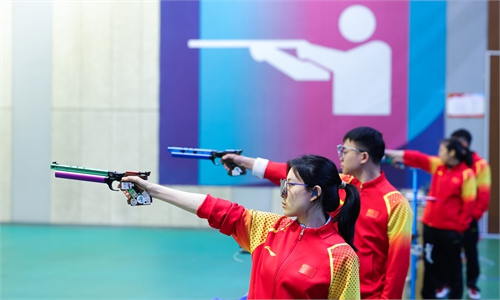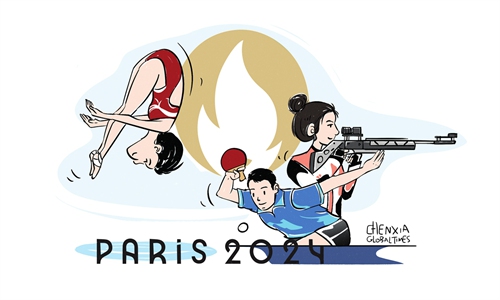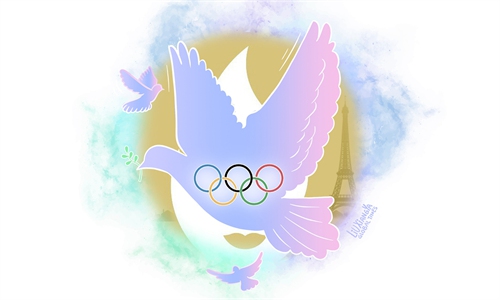ARTS / CULTURE & LEISURE
Geared up: What it’s like inside the Paris Olympic Village
What it’s like inside the Paris Olympic Village
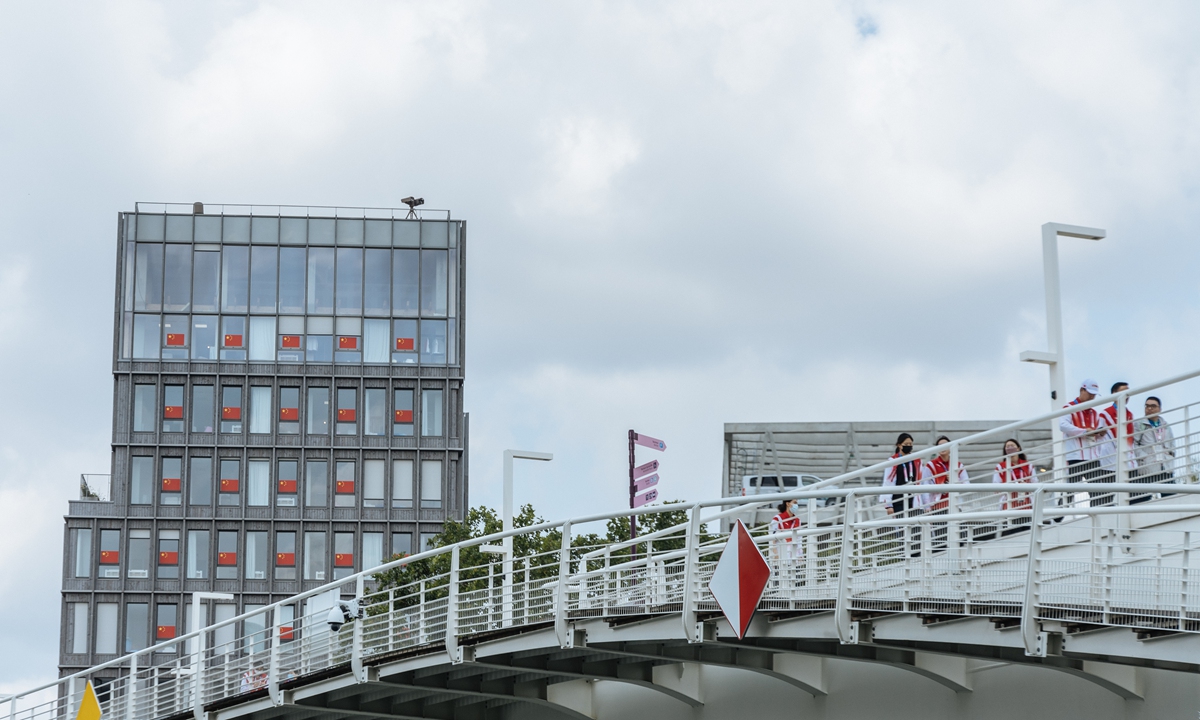
People stroll in the Olympic Village near the building designated for the Chinese delegation, decorated with the Chinese national flags, in Paris, France on July 24, 2024. Photos: Li Hao/GT
An official from China's delegation to the Paris 2024 Olympic Games said during an online press conference on Wednesday that claims that the team brought their own air conditioning and mattresses to the Olympic Village are false.
Zhang Xin, secretary-general of the Chinese Olympic delegation, clarified that the Olympic Village offers mobile air conditioning rentals, which the delegation will consider depending on the weather. He emphasized that the team did not install their own air conditioning or bring their own mattresses to the village, the Xinhua News Agency reported.
During a visit to the Olympic Village on Wednesday, the Global Times reporters saw well-prepared infrastructure facilities, a highly popular official souvenir shop, and beefed-up security measures.
The Chinese delegation and nearly 20 teams have already settled in the Olympic Village. Zhang said based on the current feedback from various teams, people are generally satisfied with the dining, facilities, and other services at the Olympic Village.
"While the Paris Olympic Village has its unique features in terms of accommodation, dining, living environment, training, competition venues, and transportation services compared to previous Olympic Games, the fundamental standards remain the same," Zhang noted.
The 53-hectare Olympic Village will host over 14,000 athletes and staff during the Paris 2024 Olympic Games and approximately 9,000 people during the Paralympic Games.
The Italian women's volleyball team left the Olympic Village due to dissatisfaction with the accommodations.
The team's spokesperson cited concerns over the quality of the village's facilities, which prompted their decision to relocate to a hotel. This move was aimed at ensuring the athletes have optimal conditions for rest and preparation ahead of their matches. The team's decision highlighted the importance of comfort and adequate preparation environments for athletes during major competitions, according to Reuters.
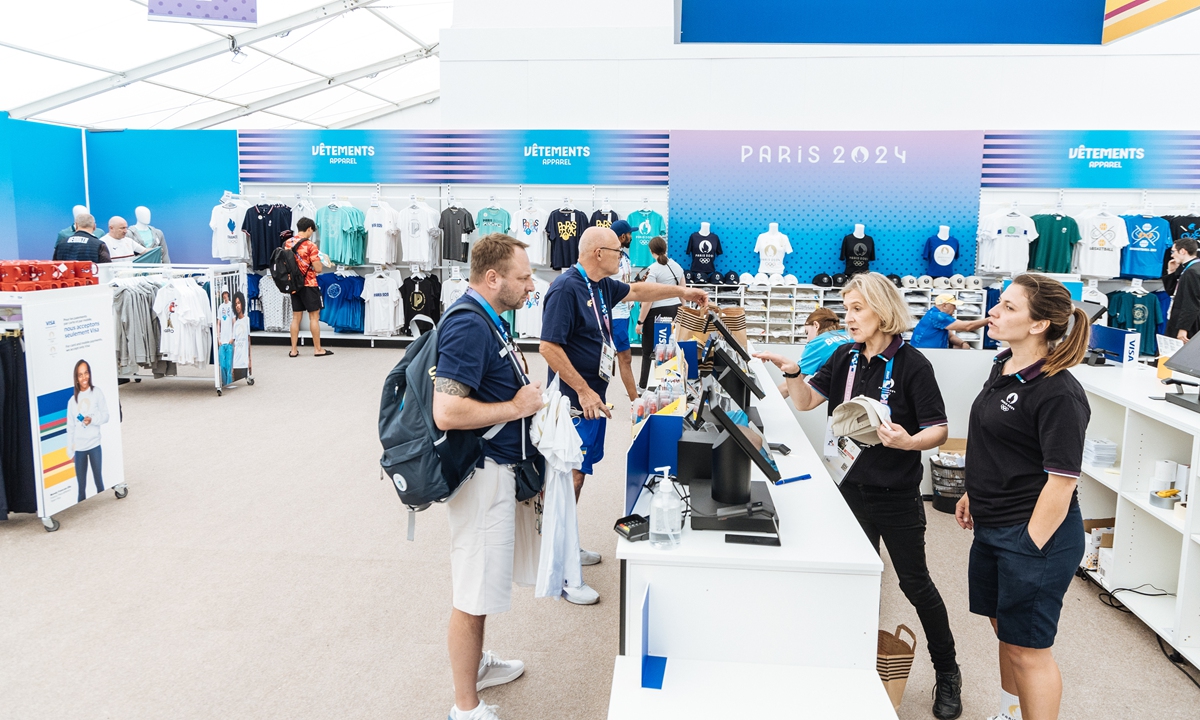
People buy souvenirs at a shop in the Olympic Village in Paris, France, on July 24, 2024. Photo: Li Hao/GT
Bustling with excitement
As one of the eco-friendly approaches to sustainability, the Paris 2024 Olympics organizers created a water-cooling system in the buildings that would keep the rooms comfortable and limit the carbon emissions of the Games.
It was rumored that the Chinese delegation brought over 300 air conditioners with them to the village, which sparked heated discussion on social media.
Another focal point is that athletes will sleep on cardboard beds in the village, a decision that underscores the Olympics' unwavering commitment to sustainability and the use of recyclable materials.
With the questions about the conditions of Olympic Village in mind, the Global Times reporters left for the athletes' village at noon.
Located in northern Paris, it is approximately 10 kilometers away from the Olympic media village. Fortunately, journalists were able to use the Olympic-dedicated lanes with their media shuttles, so the journey didn't take long. When we arrived at around 1:30 pm, the village was bustling with activity.
For journalists to enter the Olympic Village, we must first go through security checks at a designated media area. Without an invitation from someone inside the village, such as a team or an athlete, we need to go to a separate office area to register before exchanging our media accreditation for a visitor's pass, which allows us to access public areas in the village. However, we cannot enter the athletes' living quarters with this pass.
Enhanced security
Upon leaving the reception area, one first encounters a waterway running through the Olympic Village. The riverbanks are lined with lush trees, and the water is clear, offering a pleasant, breezy spot under the shade. A bridge above the river connects parts of the athletes' residential area with the public activity zones. From the bridge, one can see the Chinese athletes' apartment adorned with national flags.
Below the bridge are several white columns covered with encouraging messages in various languages. Among them, we noticed a phrase "Go all out" written in Chinese.
Continuing along the main road by the river, you will find a large "big screen" TV, surrounded by lounge chairs and parasols, creating a viewing area for the athletes. This spot allows athletes to relax under the sunshades and watch live broadcasts of the events after their competitions.
Behind the viewing area is the "commercial zone" of the Olympic Village. This area features restaurants, supermarkets, a mobile phone store, and the official souvenir shop. We observed that even before the opening of the Games, many athletes had already started purchasing souvenirs, especially clothing and accessories with Olympic elements, showing their interests in Paris as the "fashion capital."
From our hour-long visit, it was clear that the Olympic Village is well equipped. The temperature in Paris in recent days has been quite tolerable; although it is relatively hot noontime, however, cooler in the morning and evening.
Additionally, regarding to the security concerns about the village, we encountered dozens of police patrol cars and nearly a hundred police officers on our way to the village. There are also security personnel patrolling the public areas of the village to prevent unauthorized access to the athletes' living areas.
